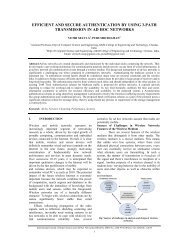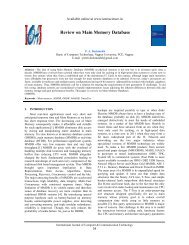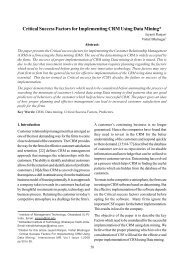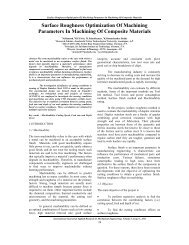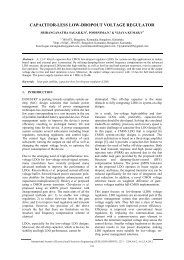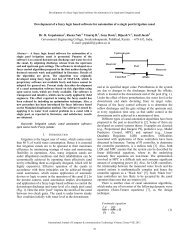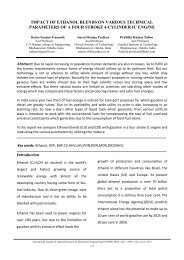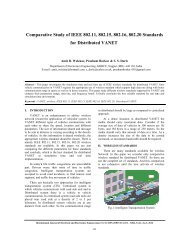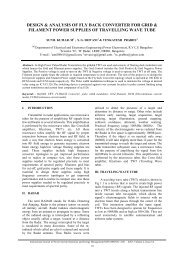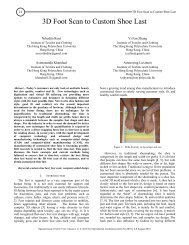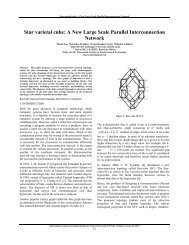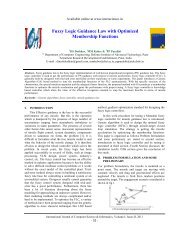Disease Diagnosis System
Disease Diagnosis System
Disease Diagnosis System
You also want an ePaper? Increase the reach of your titles
YUMPU automatically turns print PDFs into web optimized ePapers that Google loves.
knowledge is represented in the form of IF-THEN rules.<br />
Figure 2 shows different modules for a rule-based expert<br />
system.<br />
Figure 2: Expert <strong>System</strong> Architecture.<br />
Expert systems have been developed and applied to<br />
many fields.<br />
Knowledge is a theoretical or practical<br />
understanding of a subject or a domain. In other words,<br />
Knowledge is the sum of what is currently known.<br />
<strong>Diagnosis</strong> system is a system which can diagnose<br />
diseases through checking out the symptoms. A<br />
knowledge based online diagnosis system is developed<br />
for diagnosis of diseases based on the knowledge given<br />
by doctors in the system.<br />
All health care professionals including doctors<br />
medical students, pharmacists can keep their knowledge<br />
up-to-date regarding “Red-eye diagnoses and treatment”,<br />
as its knowledge base external database is updated on<br />
regular basis.<br />
III. OBJECTIVE<br />
The objectives of the proposed expert systems are:-<br />
To implement the IT in real world problems.<br />
To assist doctors for various diseases associated<br />
with symptoms i.e. to be a home assistant for<br />
doctors.<br />
To assist Medical students working as in<br />
pathological labs.<br />
To help general practice doctors, nurses,<br />
nursing students etc and to assist the eye<br />
patients as first aid diagnosis<br />
To provide researchers a huge and up-to-date<br />
repository of information regarding various<br />
diseases.<br />
IV. PROPOSED SYSTEM<br />
A Medical <strong>Diagnosis</strong> <strong>System</strong> is developed with the<br />
purpose of assisting the Physician in diagnosing several<br />
diseases. It retrieves data from previous records to<br />
<strong>Disease</strong> <strong>Diagnosis</strong> <strong>System</strong> �<br />
�<br />
improve the accuracy of current diagnosis, indicates and<br />
analyses laboratory exams and lists all the possible<br />
diseases that the patient may have.<br />
The main objective of this system is to produce<br />
relevant data and information for consultations, and with<br />
the results obtained at this stage, produce possible<br />
diagnoses. In the definition of this process, 3 modules<br />
were created, to be used by specialists. In the first<br />
module, it is possible for a specialist or any medical<br />
committee to define which symptoms, clinical exams or<br />
laboratory exams are relative to one or more illnesses<br />
and, thereby, attribute the values (statistical weights) or<br />
results that define the illness. This Means, for instance,<br />
that blood pressure can be associated to the <strong>Diagnosis</strong> of<br />
High Blood Pressure, Diabetes, Pregnancy Risk, or renal<br />
failure, among others. It also indicates, in some cases,<br />
weather this symptom result provides the certainty of<br />
diagnosis or not. Information from previous<br />
consultations and examinations are automatically linked<br />
and analysed under temporal logic reasoning.<br />
In the second module, the system allows<br />
consultations whereby the relevant data for the patient is<br />
recorded and related to other correlated exams. Data not<br />
considered are discarded. During the stage of diagnosis,<br />
the system may suggest other tests or procedures to then<br />
decide whether there are other risks or diseases to be<br />
further investigated.<br />
In the third module, a diagnosis is made whereby the<br />
system removes refutes diagnosis, redefines the<br />
remaining ones (if necessary). Also, this system searches<br />
out levels of illnesses according to exam results. It may<br />
also suggest further investigation whenever data is not<br />
enough to ensure a precise diagnose; If no further<br />
information exists, it can reason under incomplete<br />
information relaying on current data.<br />
Finally, the system asks what results will be<br />
considered for the formation of the diagnoses, and then<br />
asks the doctor which diagnoses are confirmed<br />
Fig:- Expert system Architecture<br />
�<br />
International Journal of Computer Science & Informatics, Volume-I, Issue-II, 2011<br />
��



